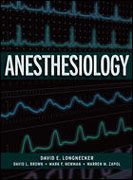
Anesthesiology
Longnecker, David E.
Brown, David L.
Newman, Mark F.
Zapol, Warren M.
INDICE: Authors. Preface. Section I. The Specialty of Anesthesiology. 1. The Evolution of Anesthesiology as a Clinical Discipline. 2. Current Scope of Anesthesia Practice. 3. Safety and Quality: The Guiding Principles of Patient Centered Care. Section II. Preparing for Anesthesia Part A: Approach to the Anesthesia patient. 4. Preoperative Evaluation of the Ambulatory Patient. 5. Developing the Anesthetic Plan Part B: Preoperative Evaluation of the Anesthesia Patient. 6. Use and Misuse of Consultants. 7. Evaluation of the Patient with Cardiovascular Disease. 8. Evaluation of the Patient with a Difficult Airway. 9.Evaluation of the Patient with Pulmonary Disease. 10. Evaluation of the Patient with Neuropsychiatric Disease. 11. Evaluation of the Patient with Neuromuscular or Skeletal Disease. 12. Evaluation of the Patient with Endocrine Diseaseor Diabetes Mellitus. 13. Evaluation of the Patient with Renal Disease. 14. Evaluation of Patients with Hepatic Disease. 15. Evaluation of the Patient withAnemia or Coagulation Disorders. 16. Evaluation of the Patient with Perioperative Malnutrition. 17. Evaluation of the Patient with Acquired Immunodeficiency Syndrome and Other Serious Infections. 18. Evaluation of the Neonate. 19. Evaluation of Children. 20. Evaluation of the Geriatric Patient. 21. Evaluation of the Pregnant Patient. 22. Evaluation of the Obese Patient. 23. Evaluation of the Patient with Alcoholism and other Drug Dependencies. Section III. Safetyand Risk Reduction in Anesthesia Practice. 24. Anesthesia Risk. 25. Approaches to Quality Improvement in Anesthesia Care. 26. Positioning of the Patient. 27. Electricity, Electrical Safety, and Instrumentation in the Operating Room. Section IV. Managing Anesthesia Care Part A: Monitoring the Anesthesia Patient. 28. Anesthesia Record. 29. Hemodynamic Monitoring. 30. Transesophageal Echocardiography. 31. Monitoring Respiratory Function. 32. Intraoperative Neurologic Monitoring. 33. Monitoring and Managing Neuromuscular Blockade. 34. Monitoring and Managing Perioperative Electrolyte Abnormalities, Acid- Base Disorders,and Fluid Replacement Part B: Managing the Airway. 35. Airway Management PartC: Anesthesia Drugs and Drug Delivery Systems. 36. Mechanism of Action of General Anesthetics. 37. Pharmacology of Inhalational Anesthetics. 38. AnesthesiaDelivery System. 39. Principles of Pharmacokinetics and Pharmacodynamics. 40.Pharmacology of Intravenous Anesthetics. 41. Pharmacology of Opioid Analgesic. 42. Total Intravenous Anesthesia. 43. Cardiovascular Drugs. 44. Pharmacologyof Local Anesthetics Part D: Regional Anesthesia. 45. Incorporating Regional Anesthesia into Anesthetic Practice. 46. Neuraxial Anesthesia. 47. Paravertebral Anesthesia. 48. Peripheral Nerve Blocks. 49. Managing Adverse Outcomes During Regional Anesthesia Part E: Specialty Areas of Anesthetic Practice. 50. Neuroanesthesia. 51. Anesthesia for Adult Cardiac Procedures. 52. Anesthesia for Treatment of Congenital Heart Disease. 53. Thoracic Anesthesia. 54. Anesthesiafor Major Vascular Surgery. 55. Anesthesia for Gastrointestinal Surgery. 56. Anesthesia for Liver Surgery and Transplantation. 57. Anesthesia for Heart or Lung Transplantation. 58. Anesthesia for Kidney Pancreas or Other Organ Transplantation. 59. Anesthesia for Endocrine Surgery. 60. Anesthetic Considerationsfor Genitourinary and Renal Surgery. 61. Anesthesia for Obstetrical Care or Gynecologic Surgery. 62. Anesthesia for Surgical Emergencies in Newborns. 63. Anesthesia for Children. 64. Anesthesia for Orthopedic Surgery. 65. Anesthesia for Ophthalmic Surgery. 66. Anesthesia for Otolaryngologic Surgery. 67. Outpatient Anesthesia. 68. Monitored Anesthesia Care and Conscious Sedation. 69. Anesthesia Care for Diagnostic or Therapeutic Procedures Outside the Operating Room. 70. Anesthesia for Trauma Patients. 71. Anesthesia for Patients with MajorBurns. Section V. Postoperative Care of the Anesthesia Patient. 72. Recovery Management of the Healthy Patient. 73. Common Postoperative Complications. 74.Management of Acute Postoperative Pain. Section VI: The Critically Ill Patient. 75. The Pathophysiology of Critical Care Illness. 76. Preoperative Evaluation of the Hospitalized or Critically Ill Patient. 77. Evaluation of the Patient with Multiple Organ Dysfunction Syndrome. 78. Evaluation of the Patient withBurns. 79. Evaluation of the Trauma Patient. 80. Developing the Anesthetic Plan for Critically Ill Patients. 81. Monitoring and Transport of the CriticallyIll Patient. 82. Postoperative Care of the Critically Ill Patient. 83. Hemodynamic Support of the Critically Ill Patient. 84. Respiratory Support of the Surgical Patient. 85. Cardiopulmonary Resuscitation. Section VII. Special Considerations in Anesthesia Care. 86. Blood and Blood Component Therapy. 87. Cognititve Dysfunction after Anesthesia. 88. Protection of the Central Nervous System. 89. Anaphylactic Reactions and Anesthesia. 90. Perioperative Hyperthermia or Hypothermia. Section VIII. Care of the Chronic Pain Patient. 91. Mechanisms of Chronic Pain. 92. Common Chronic Pain Syndromes. 93. Medical Management of Chronic Pain. 94. Interventional Management of Chronic Pain. 95. Palliative and Cancer Pain Care. Section IX. Practice Related Issues. 96. Legal Issues in Anesthesiology. 97. Substance Dependence and Abuse in Anesthesia Care Providers. 98. The Economics of Health Care and Anesthesia Practice. 99. Practice Management. Appendix. Index.
- ISBN: 978-0-07-145984-6
- Editorial: McGraw-Hill
- Encuadernacion: Cartoné
- Páginas: 2278
- Fecha Publicación: 01/02/2008
- Nº Volúmenes: 1
- Idioma: Inglés
